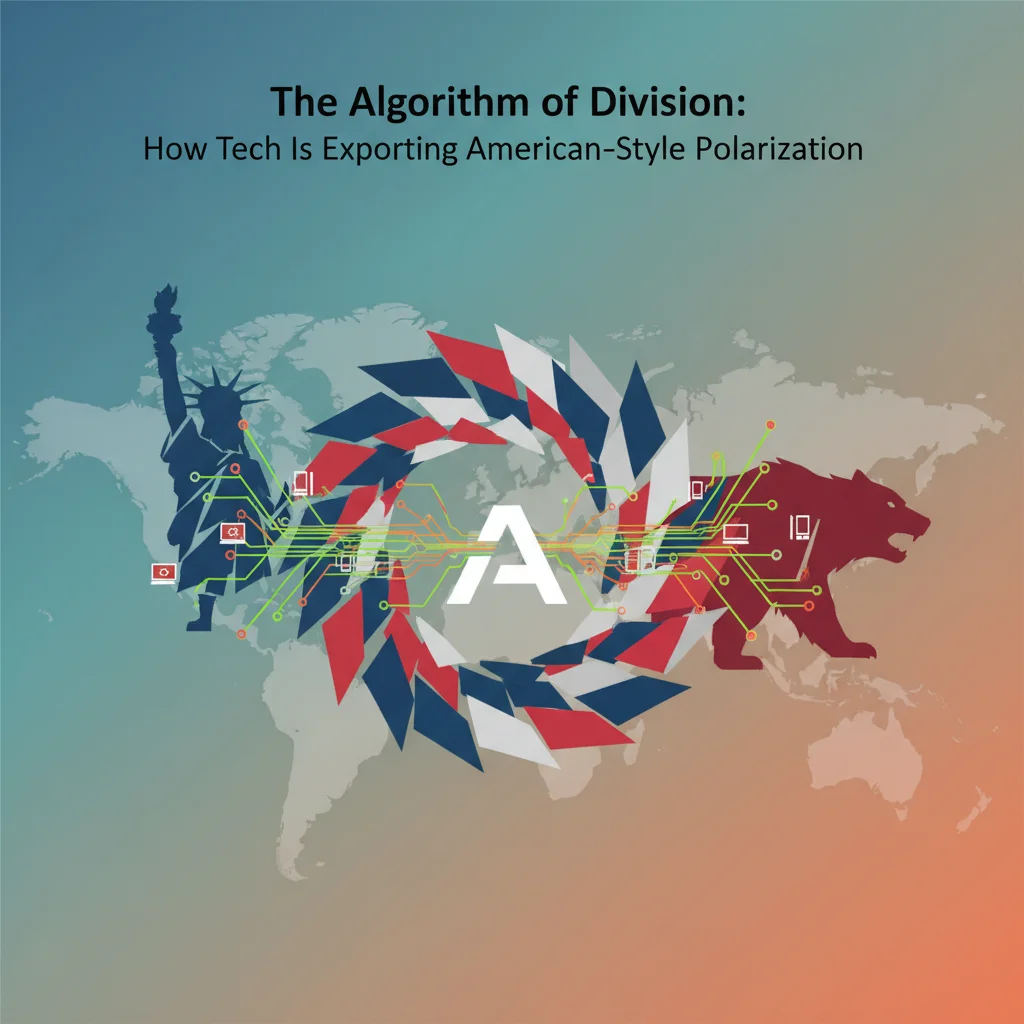
The Algorithm of Division: How Tech Is Exporting American-Style Polarization
Ever get the feeling that online political discussions have gone from disagreements to all-out tribal warfare? You’re not just imagining it. It’s a phenomenon political scientists call “affective polarization”—it’s not that we disagree more on policy, but that we’ve grown to actively dislike, distrust, and even despise those on the other side. And this isn’t just an American problem anymore. A wave of this intense division is sweeping across the Western world, and new research points to a surprising culprit: the very architecture of our modern media ecosystem.
While it’s easy to blame politicians or “the other side,” the real story is more complex and hits much closer to home for those of us in the tech industry. The incentives hard-coded into our digital world—the platforms we build, the algorithms we design, and the business models we champion—are actively fueling this fire. This isn’t a political issue; it’s a systems engineering problem with profound societal consequences.
Let’s unpack the code behind this growing conflict, exploring how the shift in media technology and business models, powered by innovation in software and AI, has created a market for division.
From Broadcast to Narrowcast: The Great Media Fragmentation
To understand where we are, we have to look at where we’ve been. For decades, the media landscape was dominated by a few major players—broadcast TV networks and national newspapers. Their business model was simple: capture the largest possible audience to sell to advertisers. This created a powerful incentive to appeal to the political center. Alienating large swaths of the population was simply bad for business.
The internet, and specifically the cloud infrastructure that powers it, shattered this model. The barriers to entry for publishing collapsed. Anyone could launch a blog, a YouTube channel, or a digital publication. This explosion of choice led to a fragmentation of the audience. The game was no longer about capturing the middle; it was about capturing a passionate, dedicated niche.
This shift fundamentally rewired the business of news. As advertising revenue became less reliable, many outlets pivoted to reader-supported models—subscriptions, memberships, and donations. In essence, news became a SaaS (Software as a Service) product. And like any good SaaS business, the key metrics became engagement, retention, and converting casual users into loyal superfans. How do you do that in a crowded market? By giving a niche audience exactly what it wants: content that validates its identity and vilifies its opponents.
This table breaks down the fundamental shift in the media ecosystem’s incentives:
| Characteristic | Old Media Model (Broadcast Era) | New Media Model (Digital Era) |
|---|---|---|
| Primary Goal | Reach the broadest possible audience | Capture and retain a loyal niche audience |
| Revenue Source | Mass-market advertising | Subscriptions, donations, targeted ads (SaaS Model) |
| Content Incentive | Inoffensiveness, appeal to the center | High engagement, identity validation, outrage |
| Key Technology | Broadcast towers, printing presses | Cloud hosting, social media, AI algorithms |
| Resulting Tone | Moderating, consensus-seeking | Polarizing, partisan, “us vs. them” |
As new research highlights, this isn’t a theoretical problem. The “supply of partisan news” has measurably increased, driven by these new economic realities. The very business models that power many successful startups are now being applied to news, with divisive results.
AI's 'Fried Chicken' Moment: Are We in a Bubble or a Revolution?
The Code Behind the Conflict: AI, Machine Learning, and the Outrage Economy
If the new business model is the engine of polarization, then artificial intelligence and machine learning are the high-octane fuel. The platforms where most people now discover and consume content—social media feeds, video-sharing sites, and news aggregators—are all governed by complex recommendation algorithms.
The programming behind these systems has a single, primary directive: maximize user engagement. The algorithm doesn’t know what “truth” or “civility” is. It only knows what keeps you scrolling, clicking, and sharing. And it has learned, through billions of data points, a dangerous truth about human psychology: nothing is more engaging than outrage.
Negative emotions—especially those related to out-group animosity—are powerful drivers of attention. A post that makes you angry at “the other side” is far more likely to elicit a comment or a share than a nuanced, balanced report. The machine learning models at the heart of these platforms recognize this pattern and optimize for it. They create a feedback loop:
- Partisan content generates high engagement.
- The algorithm identifies this content as “valuable” because it meets its engagement objective.
- It then promotes this content to more users who are likely to engage with it.
- Media creators, seeing what gets rewarded, produce more of the same polarizing content.
This creates the digital equivalent of a polluted environment. Instead of clean air, we have a constant stream of algorithmically amplified animosity. According to the Financial Times article, this isn’t just about showing you things you agree with. It’s about “negative partisanship”—the most powerful predictor of engagement is content that reinforces your dislike of the opposition (source). Your identity becomes less about what you stand for and more about who you stand against.
The Global Contagion: Exporting Division as a Service
The most alarming finding is that this model of polarization is proving to be a successful American export. The same dynamics are now playing out across Europe and other Western nations. Why? Because the underlying technology is global.
The dominant social media platforms, cloud services, and digital advertising networks are largely designed and built in Silicon Valley. They carry the DNA of its engagement-at-all-costs business model. When a media company in Spain, Germany, or the UK adopts a digital-first strategy, they are plugging into this pre-existing ecosystem. They use the same platforms, are subject to the same algorithmic rewards, and therefore adopt the same tactics to survive.
Furthermore, the use of automation allows these divisive narratives to be scaled and spread with terrifying efficiency. Bot networks can amplify trending topics, create the illusion of grassroots support for extreme views, and drown out moderate voices. This presents a massive cybersecurity challenge for democracies worldwide, as state and non-state actors can exploit these very systems to sow chaos.
The result is that a media environment that evolved to fit the unique, two-party political landscape of the US is now being retrofitted onto the multi-party, consensus-driven systems of other countries. And it’s having a corrosive effect. As one researcher noted, in countries like the Netherlands, the number of people who say they would be unhappy if their child married a supporter of an opposing party has dramatically increased in recent years—a classic sign of affective polarization taking root.
O2's Pricing Fiasco: A Masterclass in What Not to Do for SaaS and Tech Startups
What Now? Refactoring Our Digital Society
Recognizing that the code is flawed is the first step. The incentives of our current media ecosystem are misaligned with the needs of a healthy democratic society. So, what can we, as the architects of this digital world, do about it?
There are no easy answers, but the path forward involves a conscious shift in our approach to building technology:
- Rethinking Metrics: We must move beyond simplistic engagement metrics. Startups and established tech giants alike need to develop and reward more nuanced KPIs—like “time well spent,” bridging divides, or exposure to diverse perspectives.
- Algorithmic Transparency and Control: Users should have more insight into and control over why they are being shown certain content. Building tools that allow people to consciously tune their own information diet is a crucial area for innovation.
- Supporting New Models: We need to champion and build technologies that support different media models. This could mean tools for non-profits, platforms for collaborative journalism, or systems that reward nuance instead of outrage.
- Designing for Resilience: In an era of rampant misinformation, building robust cybersecurity and verification tools directly into our platforms is no longer optional. We must design systems that are resilient to manipulation.
The spread of American-style polarization isn’t inevitable. It’s a design choice. It is the result of a specific set of technological and economic incentives we created. The good news is that we can make different choices. By understanding the deep connection between the software we write and the society it creates, we can begin the critical work of debugging our democracy.


